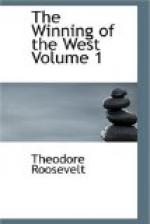2. This is one of the main reasons why the estimates of their numbers vary so hopelessly. As a specimen case, among many others, compare the estimate of Professor Benj. Smith Barton ("Origin of the Tribes and Nations of America,” Phila., 1798) with the report of the Commissioner of Indian Affairs for 1827. Barton estimated that in 1793 the Appalachian nations numbered in all 13,000 warriors; considering these as one fifth of the total population, makes it 65,000. In 1837 the Commissioner reports their numbers at 65,304—almost exactly the same. Probably both statements are nearly correct, the natural rate of increase having just about offset the loss in consequence of a partial change of home, and of Jackson’s slaughtering wars against the Creeks and Seminoles. But where they agree in the total, they vary hopelessly in the details. By Barton’s estimate, the Cherokees numbered but 7,500, the Chocktaws 30,000; by the Commissioner’s census the Cherokees numbered 21,911, the Choctaws 15,000. It is of course out of the question to believe that while in 44 years the Cherokees had increased threefold, the Choctaws had diminished one half. The terms themselves must have altered their significance or else there was extensive inter-tribal migration. Similarly, according to the reports, the Creeks had increased by 4,000—the Seminoles and Choctaws had diminished by 3,000.
3. “Am. Archives,” 4th Series, III., 790. Drayton’s account, Sept. 23, ’75. This was a carefully taken census, made by the Indian traders. Apart from the outside communities, such as the Chickamaugas at a later date, there were:
737 gun-men in the 10 overhill towns 908 " " 23 middle " 356 " " 9 lower "
a total of 2,021 warriors. The outlying towns, who had cast off their allegiance for the time being, would increase the amount by three or four hundred more.
4. “History of the American Indians, Particularly Those Nations Adjoining to the Mississippi, East and West Florida, Georgia, South and North Carolina, and Virginia.” By James Adair (an Indian trader and resident in the country for forty years), London, 1775. A very valuable book, but a good deal marred by the author’s irrepressible desire to twist every Indian utterance, habit, and ceremony into a proof that they are descended from the Ten Lost Tribes. He gives the number of Cherokee warriors at 2,300.
5. Hawkins, Pickens, Martin, and McIntosh, in their letter, give them 800 warriors: most other estimates make the number smaller.
6. Almost all the early writers make them more numerous. Adair gives them 4,500 warriors, Hawkins 6,000. But much less seems to have been known about them than about the Creeks, Cherokees, and Chickasaws; and most early estimates of Indians were largest when made of the least-known tribes. Adair’s statement is probably the most trustworthy. The first accurate census showed the Creeks to be more numerous.




